Vodafone: Human Capital and Leadership Report - Strategies and Models
VerifiedAdded on 2021/02/22
|15
|5500
|42
Report
AI Summary
This report provides a comprehensive literature review on Vodafone's human capital management and leadership. It explores the application of various models and concepts, including scientific management and human relations theory, to enhance workforce productivity and efficiency. The report delves into the critical role of recruitment and selection processes, outlining different methods and strategic initiatives employed by Vodafone. It also examines the approaches to human resource development (HRD), classical theories of motivation, and the characteristics of effective leadership within the organization. The report highlights Vodafone's strategies for optimizing manpower contribution, building a strong employer brand, and leveraging technology to improve recruitment and selection. Overall, the report offers valuable insights into Vodafone's approach to managing human capital and fostering effective leadership to achieve its business objectives.
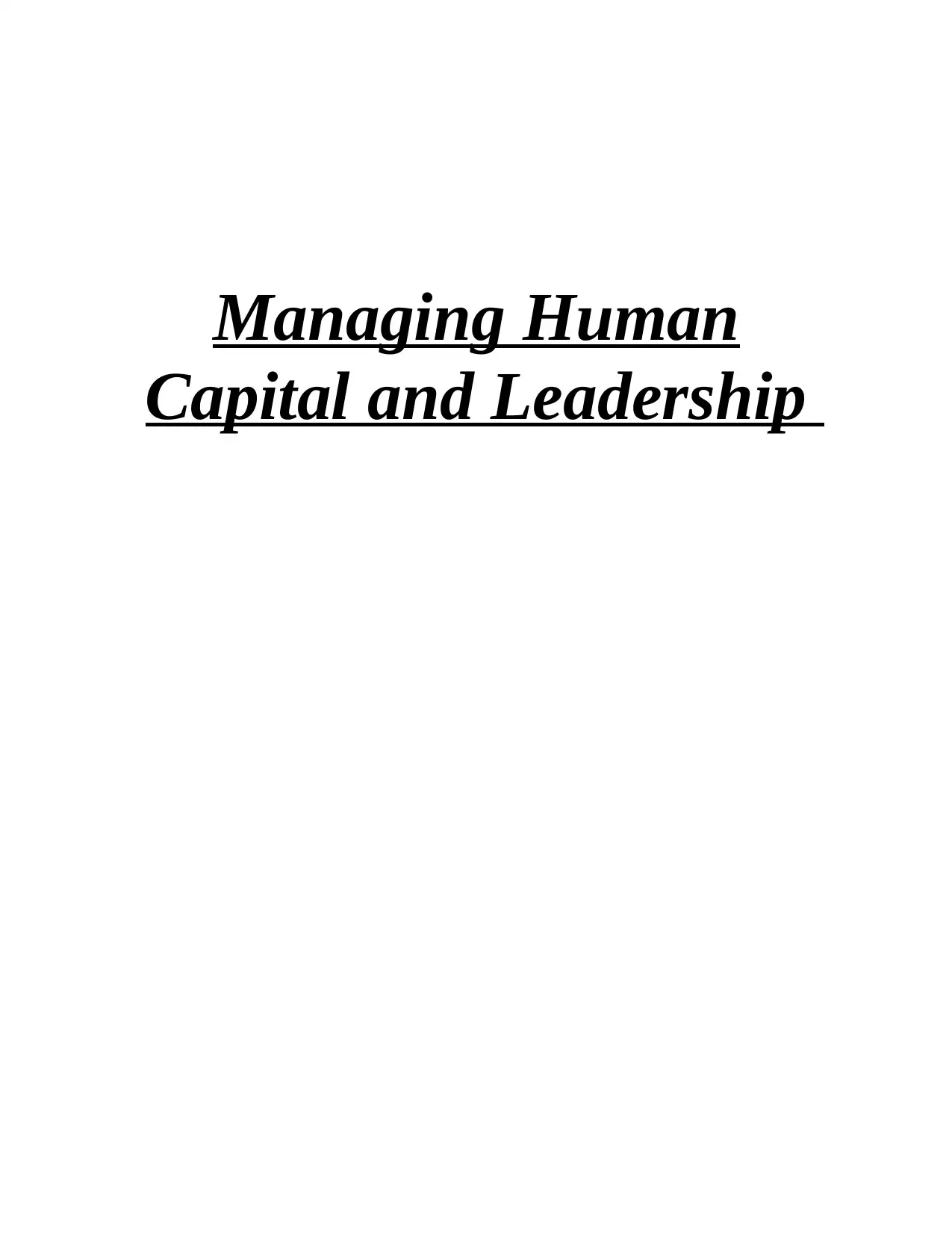
Managing Human
Capital and Leadership
Capital and Leadership
Paraphrase This Document
Need a fresh take? Get an instant paraphrase of this document with our AI Paraphraser
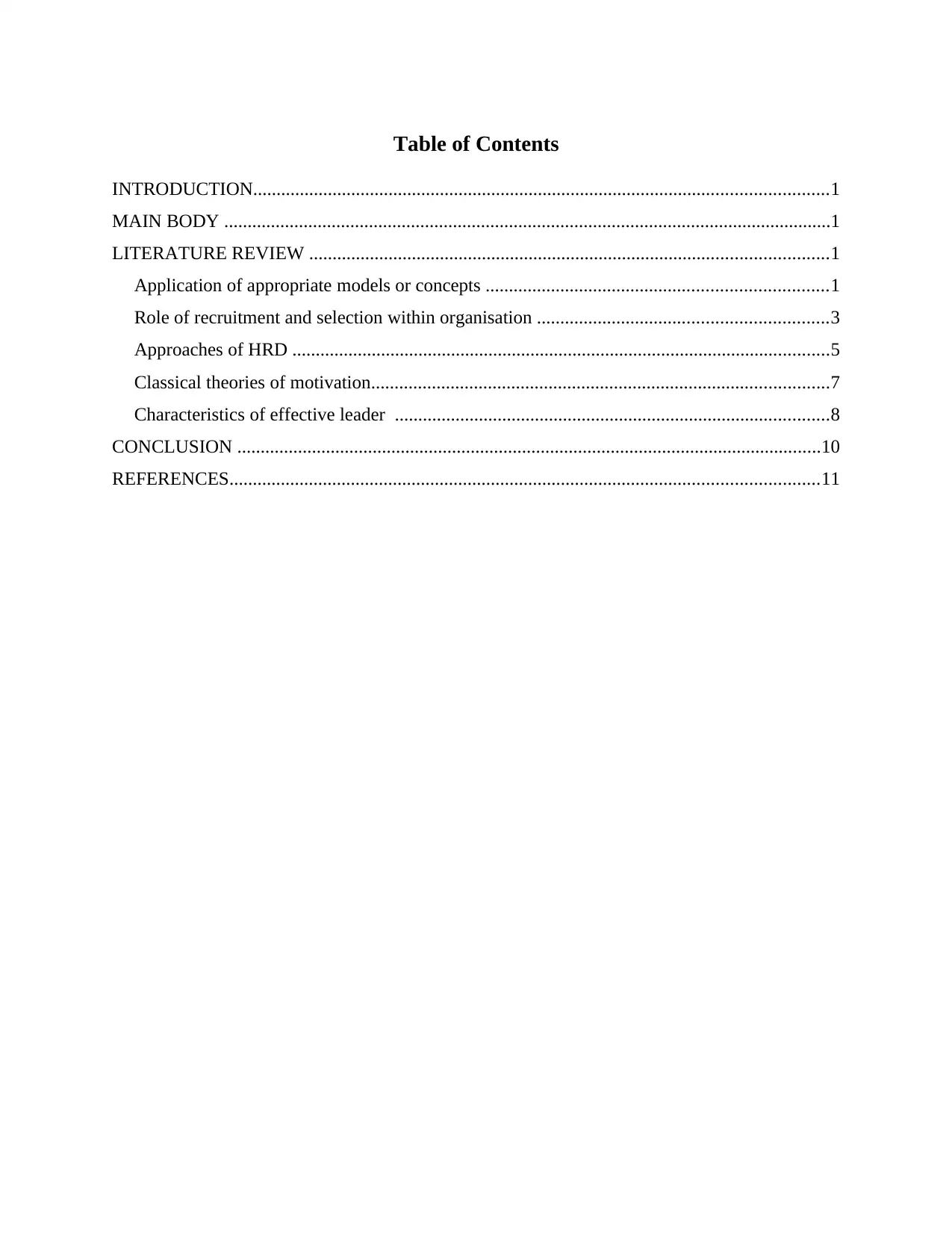
Table of Contents
INTRODUCTION...........................................................................................................................1
MAIN BODY ..................................................................................................................................1
LITERATURE REVIEW ...............................................................................................................1
Application of appropriate models or concepts .........................................................................1
Role of recruitment and selection within organisation ..............................................................3
Approaches of HRD ...................................................................................................................5
Classical theories of motivation..................................................................................................7
Characteristics of effective leader .............................................................................................8
CONCLUSION .............................................................................................................................10
REFERENCES..............................................................................................................................11
INTRODUCTION...........................................................................................................................1
MAIN BODY ..................................................................................................................................1
LITERATURE REVIEW ...............................................................................................................1
Application of appropriate models or concepts .........................................................................1
Role of recruitment and selection within organisation ..............................................................3
Approaches of HRD ...................................................................................................................5
Classical theories of motivation..................................................................................................7
Characteristics of effective leader .............................................................................................8
CONCLUSION .............................................................................................................................10
REFERENCES..............................................................................................................................11
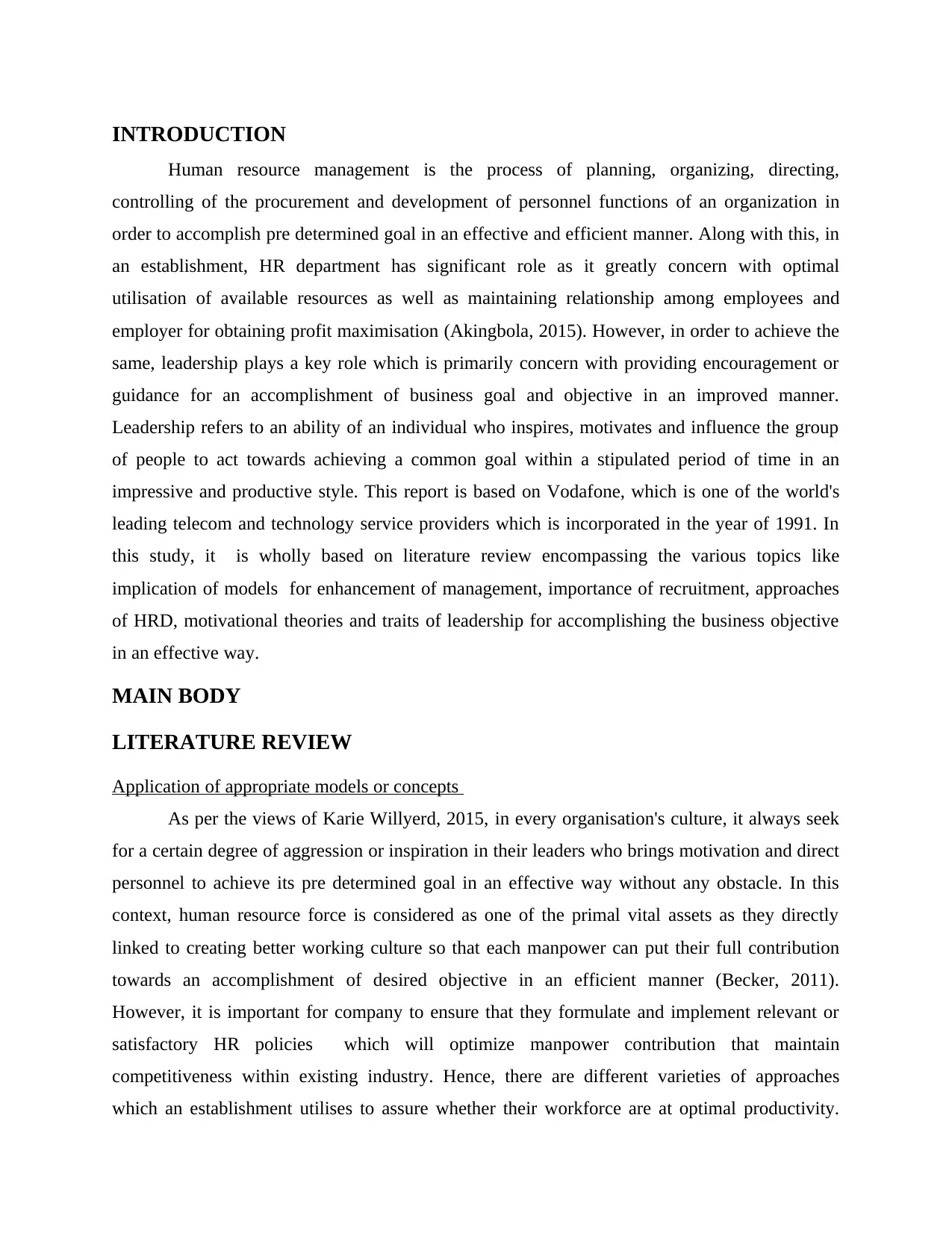
INTRODUCTION
Human resource management is the process of planning, organizing, directing,
controlling of the procurement and development of personnel functions of an organization in
order to accomplish pre determined goal in an effective and efficient manner. Along with this, in
an establishment, HR department has significant role as it greatly concern with optimal
utilisation of available resources as well as maintaining relationship among employees and
employer for obtaining profit maximisation (Akingbola, 2015). However, in order to achieve the
same, leadership plays a key role which is primarily concern with providing encouragement or
guidance for an accomplishment of business goal and objective in an improved manner.
Leadership refers to an ability of an individual who inspires, motivates and influence the group
of people to act towards achieving a common goal within a stipulated period of time in an
impressive and productive style. This report is based on Vodafone, which is one of the world's
leading telecom and technology service providers which is incorporated in the year of 1991. In
this study, it is wholly based on literature review encompassing the various topics like
implication of models for enhancement of management, importance of recruitment, approaches
of HRD, motivational theories and traits of leadership for accomplishing the business objective
in an effective way.
MAIN BODY
LITERATURE REVIEW
Application of appropriate models or concepts
As per the views of Karie Willyerd, 2015, in every organisation's culture, it always seek
for a certain degree of aggression or inspiration in their leaders who brings motivation and direct
personnel to achieve its pre determined goal in an effective way without any obstacle. In this
context, human resource force is considered as one of the primal vital assets as they directly
linked to creating better working culture so that each manpower can put their full contribution
towards an accomplishment of desired objective in an efficient manner (Becker, 2011).
However, it is important for company to ensure that they formulate and implement relevant or
satisfactory HR policies which will optimize manpower contribution that maintain
competitiveness within existing industry. Hence, there are different varieties of approaches
which an establishment utilises to assure whether their workforce are at optimal productivity.
Human resource management is the process of planning, organizing, directing,
controlling of the procurement and development of personnel functions of an organization in
order to accomplish pre determined goal in an effective and efficient manner. Along with this, in
an establishment, HR department has significant role as it greatly concern with optimal
utilisation of available resources as well as maintaining relationship among employees and
employer for obtaining profit maximisation (Akingbola, 2015). However, in order to achieve the
same, leadership plays a key role which is primarily concern with providing encouragement or
guidance for an accomplishment of business goal and objective in an improved manner.
Leadership refers to an ability of an individual who inspires, motivates and influence the group
of people to act towards achieving a common goal within a stipulated period of time in an
impressive and productive style. This report is based on Vodafone, which is one of the world's
leading telecom and technology service providers which is incorporated in the year of 1991. In
this study, it is wholly based on literature review encompassing the various topics like
implication of models for enhancement of management, importance of recruitment, approaches
of HRD, motivational theories and traits of leadership for accomplishing the business objective
in an effective way.
MAIN BODY
LITERATURE REVIEW
Application of appropriate models or concepts
As per the views of Karie Willyerd, 2015, in every organisation's culture, it always seek
for a certain degree of aggression or inspiration in their leaders who brings motivation and direct
personnel to achieve its pre determined goal in an effective way without any obstacle. In this
context, human resource force is considered as one of the primal vital assets as they directly
linked to creating better working culture so that each manpower can put their full contribution
towards an accomplishment of desired objective in an efficient manner (Becker, 2011).
However, it is important for company to ensure that they formulate and implement relevant or
satisfactory HR policies which will optimize manpower contribution that maintain
competitiveness within existing industry. Hence, there are different varieties of approaches
which an establishment utilises to assure whether their workforce are at optimal productivity.
⊘ This is a preview!⊘
Do you want full access?
Subscribe today to unlock all pages.

Trusted by 1+ million students worldwide
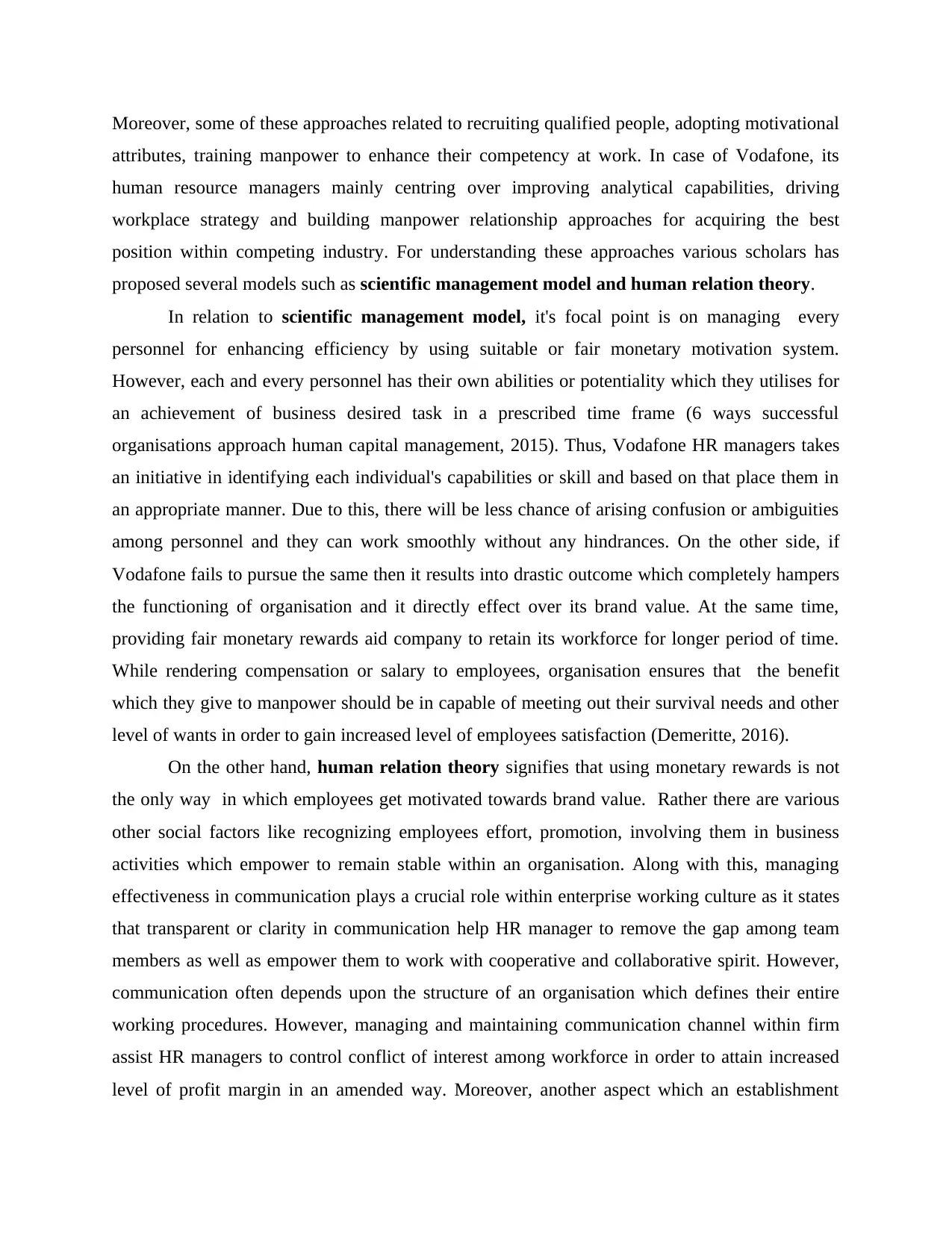
Moreover, some of these approaches related to recruiting qualified people, adopting motivational
attributes, training manpower to enhance their competency at work. In case of Vodafone, its
human resource managers mainly centring over improving analytical capabilities, driving
workplace strategy and building manpower relationship approaches for acquiring the best
position within competing industry. For understanding these approaches various scholars has
proposed several models such as scientific management model and human relation theory.
In relation to scientific management model, it's focal point is on managing every
personnel for enhancing efficiency by using suitable or fair monetary motivation system.
However, each and every personnel has their own abilities or potentiality which they utilises for
an achievement of business desired task in a prescribed time frame (6 ways successful
organisations approach human capital management, 2015). Thus, Vodafone HR managers takes
an initiative in identifying each individual's capabilities or skill and based on that place them in
an appropriate manner. Due to this, there will be less chance of arising confusion or ambiguities
among personnel and they can work smoothly without any hindrances. On the other side, if
Vodafone fails to pursue the same then it results into drastic outcome which completely hampers
the functioning of organisation and it directly effect over its brand value. At the same time,
providing fair monetary rewards aid company to retain its workforce for longer period of time.
While rendering compensation or salary to employees, organisation ensures that the benefit
which they give to manpower should be in capable of meeting out their survival needs and other
level of wants in order to gain increased level of employees satisfaction (Demeritte, 2016).
On the other hand, human relation theory signifies that using monetary rewards is not
the only way in which employees get motivated towards brand value. Rather there are various
other social factors like recognizing employees effort, promotion, involving them in business
activities which empower to remain stable within an organisation. Along with this, managing
effectiveness in communication plays a crucial role within enterprise working culture as it states
that transparent or clarity in communication help HR manager to remove the gap among team
members as well as empower them to work with cooperative and collaborative spirit. However,
communication often depends upon the structure of an organisation which defines their entire
working procedures. However, managing and maintaining communication channel within firm
assist HR managers to control conflict of interest among workforce in order to attain increased
level of profit margin in an amended way. Moreover, another aspect which an establishment
attributes, training manpower to enhance their competency at work. In case of Vodafone, its
human resource managers mainly centring over improving analytical capabilities, driving
workplace strategy and building manpower relationship approaches for acquiring the best
position within competing industry. For understanding these approaches various scholars has
proposed several models such as scientific management model and human relation theory.
In relation to scientific management model, it's focal point is on managing every
personnel for enhancing efficiency by using suitable or fair monetary motivation system.
However, each and every personnel has their own abilities or potentiality which they utilises for
an achievement of business desired task in a prescribed time frame (6 ways successful
organisations approach human capital management, 2015). Thus, Vodafone HR managers takes
an initiative in identifying each individual's capabilities or skill and based on that place them in
an appropriate manner. Due to this, there will be less chance of arising confusion or ambiguities
among personnel and they can work smoothly without any hindrances. On the other side, if
Vodafone fails to pursue the same then it results into drastic outcome which completely hampers
the functioning of organisation and it directly effect over its brand value. At the same time,
providing fair monetary rewards aid company to retain its workforce for longer period of time.
While rendering compensation or salary to employees, organisation ensures that the benefit
which they give to manpower should be in capable of meeting out their survival needs and other
level of wants in order to gain increased level of employees satisfaction (Demeritte, 2016).
On the other hand, human relation theory signifies that using monetary rewards is not
the only way in which employees get motivated towards brand value. Rather there are various
other social factors like recognizing employees effort, promotion, involving them in business
activities which empower to remain stable within an organisation. Along with this, managing
effectiveness in communication plays a crucial role within enterprise working culture as it states
that transparent or clarity in communication help HR manager to remove the gap among team
members as well as empower them to work with cooperative and collaborative spirit. However,
communication often depends upon the structure of an organisation which defines their entire
working procedures. However, managing and maintaining communication channel within firm
assist HR managers to control conflict of interest among workforce in order to attain increased
level of profit margin in an amended way. Moreover, another aspect which an establishment
Paraphrase This Document
Need a fresh take? Get an instant paraphrase of this document with our AI Paraphraser
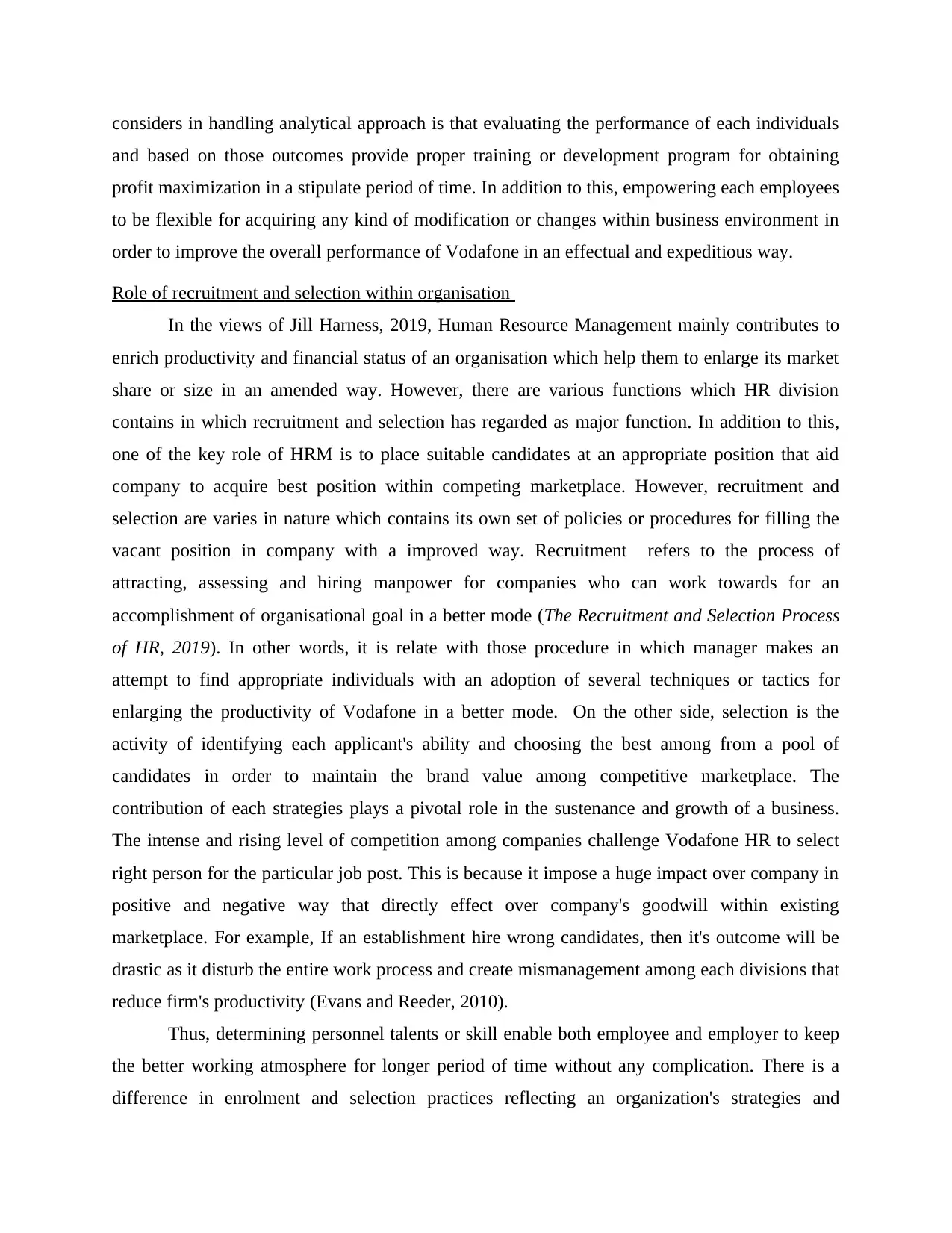
considers in handling analytical approach is that evaluating the performance of each individuals
and based on those outcomes provide proper training or development program for obtaining
profit maximization in a stipulate period of time. In addition to this, empowering each employees
to be flexible for acquiring any kind of modification or changes within business environment in
order to improve the overall performance of Vodafone in an effectual and expeditious way.
Role of recruitment and selection within organisation
In the views of Jill Harness, 2019, Human Resource Management mainly contributes to
enrich productivity and financial status of an organisation which help them to enlarge its market
share or size in an amended way. However, there are various functions which HR division
contains in which recruitment and selection has regarded as major function. In addition to this,
one of the key role of HRM is to place suitable candidates at an appropriate position that aid
company to acquire best position within competing marketplace. However, recruitment and
selection are varies in nature which contains its own set of policies or procedures for filling the
vacant position in company with a improved way. Recruitment refers to the process of
attracting, assessing and hiring manpower for companies who can work towards for an
accomplishment of organisational goal in a better mode (The Recruitment and Selection Process
of HR, 2019). In other words, it is relate with those procedure in which manager makes an
attempt to find appropriate individuals with an adoption of several techniques or tactics for
enlarging the productivity of Vodafone in a better mode. On the other side, selection is the
activity of identifying each applicant's ability and choosing the best among from a pool of
candidates in order to maintain the brand value among competitive marketplace. The
contribution of each strategies plays a pivotal role in the sustenance and growth of a business.
The intense and rising level of competition among companies challenge Vodafone HR to select
right person for the particular job post. This is because it impose a huge impact over company in
positive and negative way that directly effect over company's goodwill within existing
marketplace. For example, If an establishment hire wrong candidates, then it's outcome will be
drastic as it disturb the entire work process and create mismanagement among each divisions that
reduce firm's productivity (Evans and Reeder, 2010).
Thus, determining personnel talents or skill enable both employee and employer to keep
the better working atmosphere for longer period of time without any complication. There is a
difference in enrolment and selection practices reflecting an organization's strategies and
and based on those outcomes provide proper training or development program for obtaining
profit maximization in a stipulate period of time. In addition to this, empowering each employees
to be flexible for acquiring any kind of modification or changes within business environment in
order to improve the overall performance of Vodafone in an effectual and expeditious way.
Role of recruitment and selection within organisation
In the views of Jill Harness, 2019, Human Resource Management mainly contributes to
enrich productivity and financial status of an organisation which help them to enlarge its market
share or size in an amended way. However, there are various functions which HR division
contains in which recruitment and selection has regarded as major function. In addition to this,
one of the key role of HRM is to place suitable candidates at an appropriate position that aid
company to acquire best position within competing marketplace. However, recruitment and
selection are varies in nature which contains its own set of policies or procedures for filling the
vacant position in company with a improved way. Recruitment refers to the process of
attracting, assessing and hiring manpower for companies who can work towards for an
accomplishment of organisational goal in a better mode (The Recruitment and Selection Process
of HR, 2019). In other words, it is relate with those procedure in which manager makes an
attempt to find appropriate individuals with an adoption of several techniques or tactics for
enlarging the productivity of Vodafone in a better mode. On the other side, selection is the
activity of identifying each applicant's ability and choosing the best among from a pool of
candidates in order to maintain the brand value among competitive marketplace. The
contribution of each strategies plays a pivotal role in the sustenance and growth of a business.
The intense and rising level of competition among companies challenge Vodafone HR to select
right person for the particular job post. This is because it impose a huge impact over company in
positive and negative way that directly effect over company's goodwill within existing
marketplace. For example, If an establishment hire wrong candidates, then it's outcome will be
drastic as it disturb the entire work process and create mismanagement among each divisions that
reduce firm's productivity (Evans and Reeder, 2010).
Thus, determining personnel talents or skill enable both employee and employer to keep
the better working atmosphere for longer period of time without any complication. There is a
difference in enrolment and selection practices reflecting an organization's strategies and
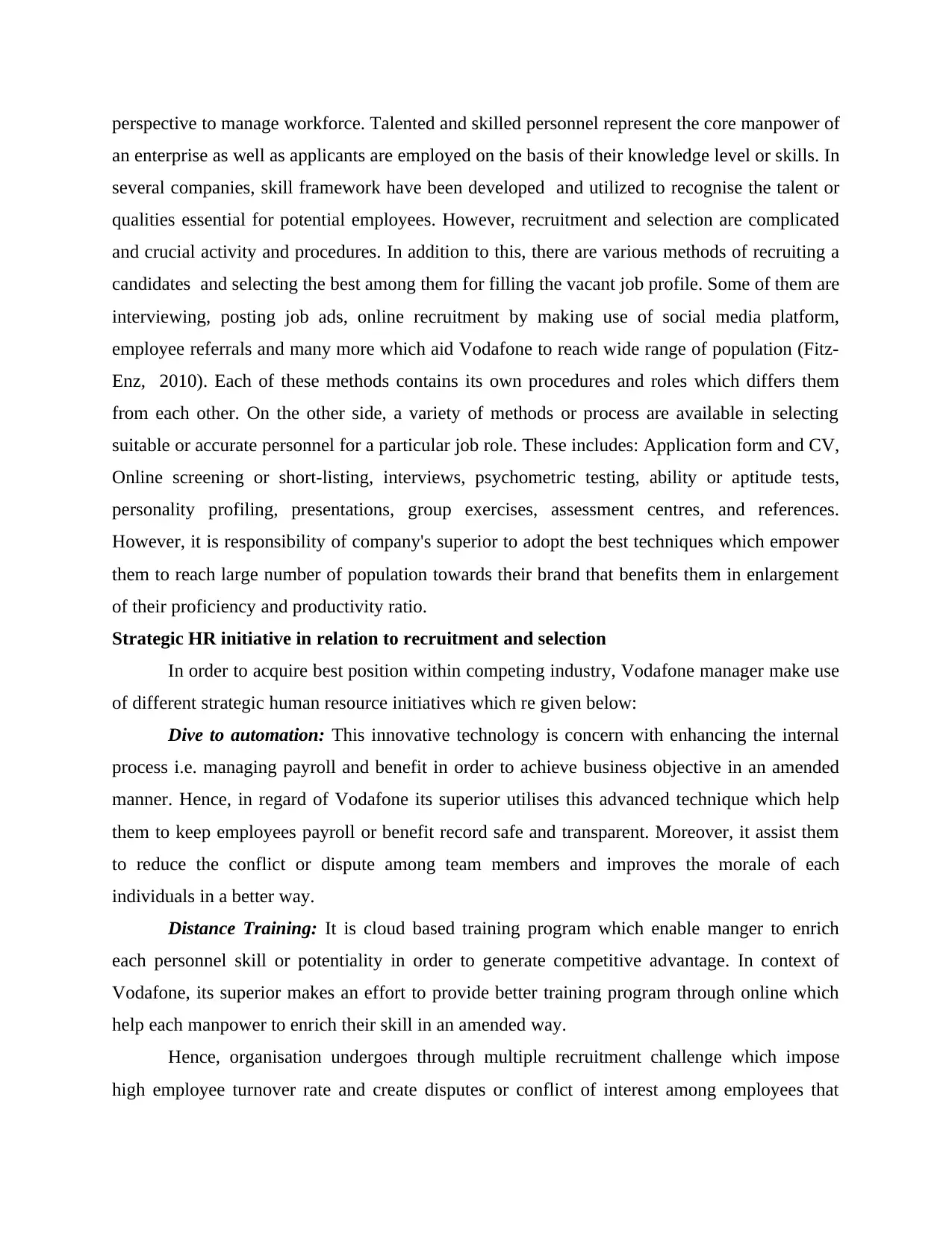
perspective to manage workforce. Talented and skilled personnel represent the core manpower of
an enterprise as well as applicants are employed on the basis of their knowledge level or skills. In
several companies, skill framework have been developed and utilized to recognise the talent or
qualities essential for potential employees. However, recruitment and selection are complicated
and crucial activity and procedures. In addition to this, there are various methods of recruiting a
candidates and selecting the best among them for filling the vacant job profile. Some of them are
interviewing, posting job ads, online recruitment by making use of social media platform,
employee referrals and many more which aid Vodafone to reach wide range of population (Fitz-
Enz, 2010). Each of these methods contains its own procedures and roles which differs them
from each other. On the other side, a variety of methods or process are available in selecting
suitable or accurate personnel for a particular job role. These includes: Application form and CV,
Online screening or short-listing, interviews, psychometric testing, ability or aptitude tests,
personality profiling, presentations, group exercises, assessment centres, and references.
However, it is responsibility of company's superior to adopt the best techniques which empower
them to reach large number of population towards their brand that benefits them in enlargement
of their proficiency and productivity ratio.
Strategic HR initiative in relation to recruitment and selection
In order to acquire best position within competing industry, Vodafone manager make use
of different strategic human resource initiatives which re given below:
Dive to automation: This innovative technology is concern with enhancing the internal
process i.e. managing payroll and benefit in order to achieve business objective in an amended
manner. Hence, in regard of Vodafone its superior utilises this advanced technique which help
them to keep employees payroll or benefit record safe and transparent. Moreover, it assist them
to reduce the conflict or dispute among team members and improves the morale of each
individuals in a better way.
Distance Training: It is cloud based training program which enable manger to enrich
each personnel skill or potentiality in order to generate competitive advantage. In context of
Vodafone, its superior makes an effort to provide better training program through online which
help each manpower to enrich their skill in an amended way.
Hence, organisation undergoes through multiple recruitment challenge which impose
high employee turnover rate and create disputes or conflict of interest among employees that
an enterprise as well as applicants are employed on the basis of their knowledge level or skills. In
several companies, skill framework have been developed and utilized to recognise the talent or
qualities essential for potential employees. However, recruitment and selection are complicated
and crucial activity and procedures. In addition to this, there are various methods of recruiting a
candidates and selecting the best among them for filling the vacant job profile. Some of them are
interviewing, posting job ads, online recruitment by making use of social media platform,
employee referrals and many more which aid Vodafone to reach wide range of population (Fitz-
Enz, 2010). Each of these methods contains its own procedures and roles which differs them
from each other. On the other side, a variety of methods or process are available in selecting
suitable or accurate personnel for a particular job role. These includes: Application form and CV,
Online screening or short-listing, interviews, psychometric testing, ability or aptitude tests,
personality profiling, presentations, group exercises, assessment centres, and references.
However, it is responsibility of company's superior to adopt the best techniques which empower
them to reach large number of population towards their brand that benefits them in enlargement
of their proficiency and productivity ratio.
Strategic HR initiative in relation to recruitment and selection
In order to acquire best position within competing industry, Vodafone manager make use
of different strategic human resource initiatives which re given below:
Dive to automation: This innovative technology is concern with enhancing the internal
process i.e. managing payroll and benefit in order to achieve business objective in an amended
manner. Hence, in regard of Vodafone its superior utilises this advanced technique which help
them to keep employees payroll or benefit record safe and transparent. Moreover, it assist them
to reduce the conflict or dispute among team members and improves the morale of each
individuals in a better way.
Distance Training: It is cloud based training program which enable manger to enrich
each personnel skill or potentiality in order to generate competitive advantage. In context of
Vodafone, its superior makes an effort to provide better training program through online which
help each manpower to enrich their skill in an amended way.
Hence, organisation undergoes through multiple recruitment challenge which impose
high employee turnover rate and create disputes or conflict of interest among employees that
⊘ This is a preview!⊘
Do you want full access?
Subscribe today to unlock all pages.

Trusted by 1+ million students worldwide
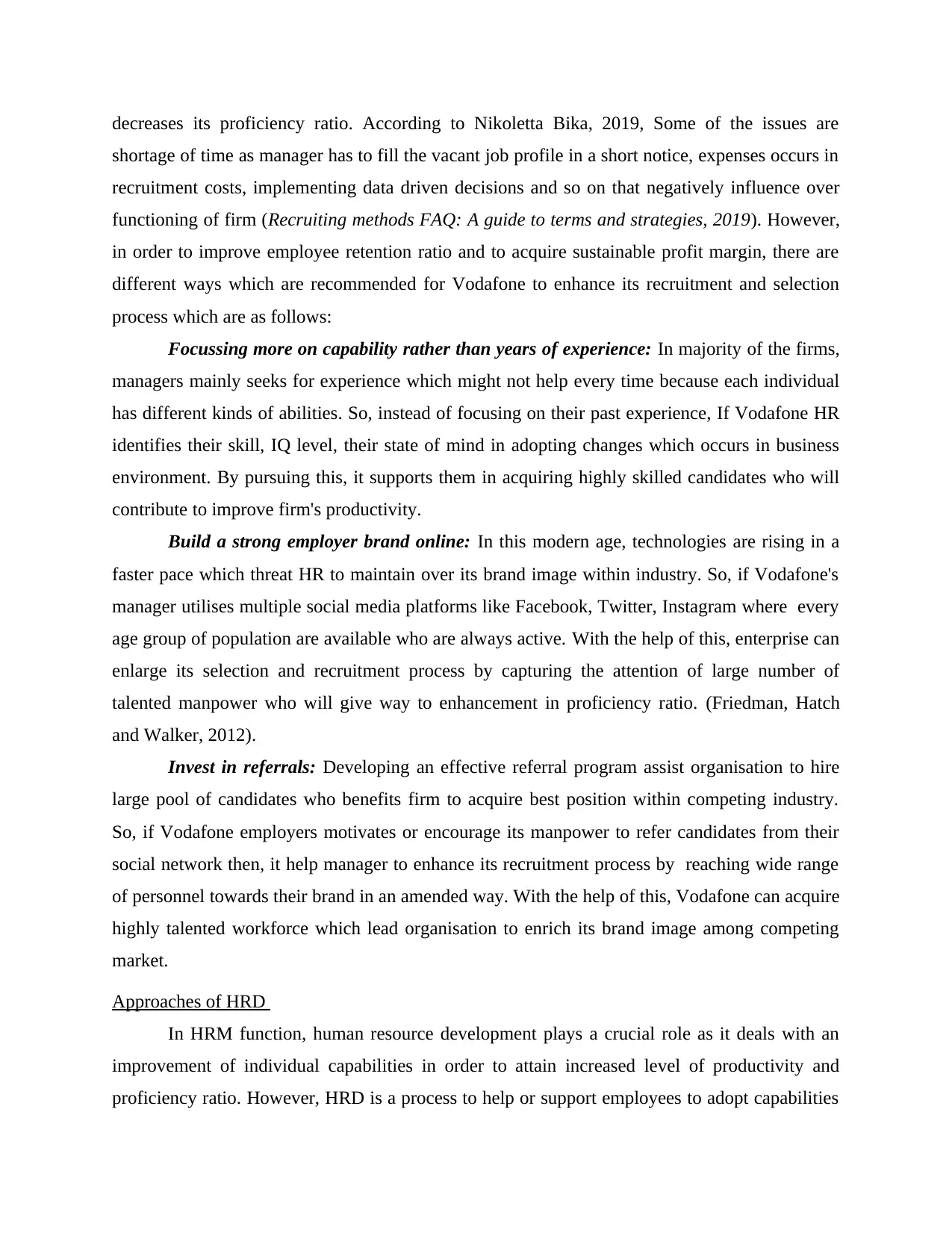
decreases its proficiency ratio. According to Nikoletta Bika, 2019, Some of the issues are
shortage of time as manager has to fill the vacant job profile in a short notice, expenses occurs in
recruitment costs, implementing data driven decisions and so on that negatively influence over
functioning of firm (Recruiting methods FAQ: A guide to terms and strategies, 2019). However,
in order to improve employee retention ratio and to acquire sustainable profit margin, there are
different ways which are recommended for Vodafone to enhance its recruitment and selection
process which are as follows:
Focussing more on capability rather than years of experience: In majority of the firms,
managers mainly seeks for experience which might not help every time because each individual
has different kinds of abilities. So, instead of focusing on their past experience, If Vodafone HR
identifies their skill, IQ level, their state of mind in adopting changes which occurs in business
environment. By pursuing this, it supports them in acquiring highly skilled candidates who will
contribute to improve firm's productivity.
Build a strong employer brand online: In this modern age, technologies are rising in a
faster pace which threat HR to maintain over its brand image within industry. So, if Vodafone's
manager utilises multiple social media platforms like Facebook, Twitter, Instagram where every
age group of population are available who are always active. With the help of this, enterprise can
enlarge its selection and recruitment process by capturing the attention of large number of
talented manpower who will give way to enhancement in proficiency ratio. (Friedman, Hatch
and Walker, 2012).
Invest in referrals: Developing an effective referral program assist organisation to hire
large pool of candidates who benefits firm to acquire best position within competing industry.
So, if Vodafone employers motivates or encourage its manpower to refer candidates from their
social network then, it help manager to enhance its recruitment process by reaching wide range
of personnel towards their brand in an amended way. With the help of this, Vodafone can acquire
highly talented workforce which lead organisation to enrich its brand image among competing
market.
Approaches of HRD
In HRM function, human resource development plays a crucial role as it deals with an
improvement of individual capabilities in order to attain increased level of productivity and
proficiency ratio. However, HRD is a process to help or support employees to adopt capabilities
shortage of time as manager has to fill the vacant job profile in a short notice, expenses occurs in
recruitment costs, implementing data driven decisions and so on that negatively influence over
functioning of firm (Recruiting methods FAQ: A guide to terms and strategies, 2019). However,
in order to improve employee retention ratio and to acquire sustainable profit margin, there are
different ways which are recommended for Vodafone to enhance its recruitment and selection
process which are as follows:
Focussing more on capability rather than years of experience: In majority of the firms,
managers mainly seeks for experience which might not help every time because each individual
has different kinds of abilities. So, instead of focusing on their past experience, If Vodafone HR
identifies their skill, IQ level, their state of mind in adopting changes which occurs in business
environment. By pursuing this, it supports them in acquiring highly skilled candidates who will
contribute to improve firm's productivity.
Build a strong employer brand online: In this modern age, technologies are rising in a
faster pace which threat HR to maintain over its brand image within industry. So, if Vodafone's
manager utilises multiple social media platforms like Facebook, Twitter, Instagram where every
age group of population are available who are always active. With the help of this, enterprise can
enlarge its selection and recruitment process by capturing the attention of large number of
talented manpower who will give way to enhancement in proficiency ratio. (Friedman, Hatch
and Walker, 2012).
Invest in referrals: Developing an effective referral program assist organisation to hire
large pool of candidates who benefits firm to acquire best position within competing industry.
So, if Vodafone employers motivates or encourage its manpower to refer candidates from their
social network then, it help manager to enhance its recruitment process by reaching wide range
of personnel towards their brand in an amended way. With the help of this, Vodafone can acquire
highly talented workforce which lead organisation to enrich its brand image among competing
market.
Approaches of HRD
In HRM function, human resource development plays a crucial role as it deals with an
improvement of individual capabilities in order to attain increased level of productivity and
proficiency ratio. However, HRD is a process to help or support employees to adopt capabilities
Paraphrase This Document
Need a fresh take? Get an instant paraphrase of this document with our AI Paraphraser
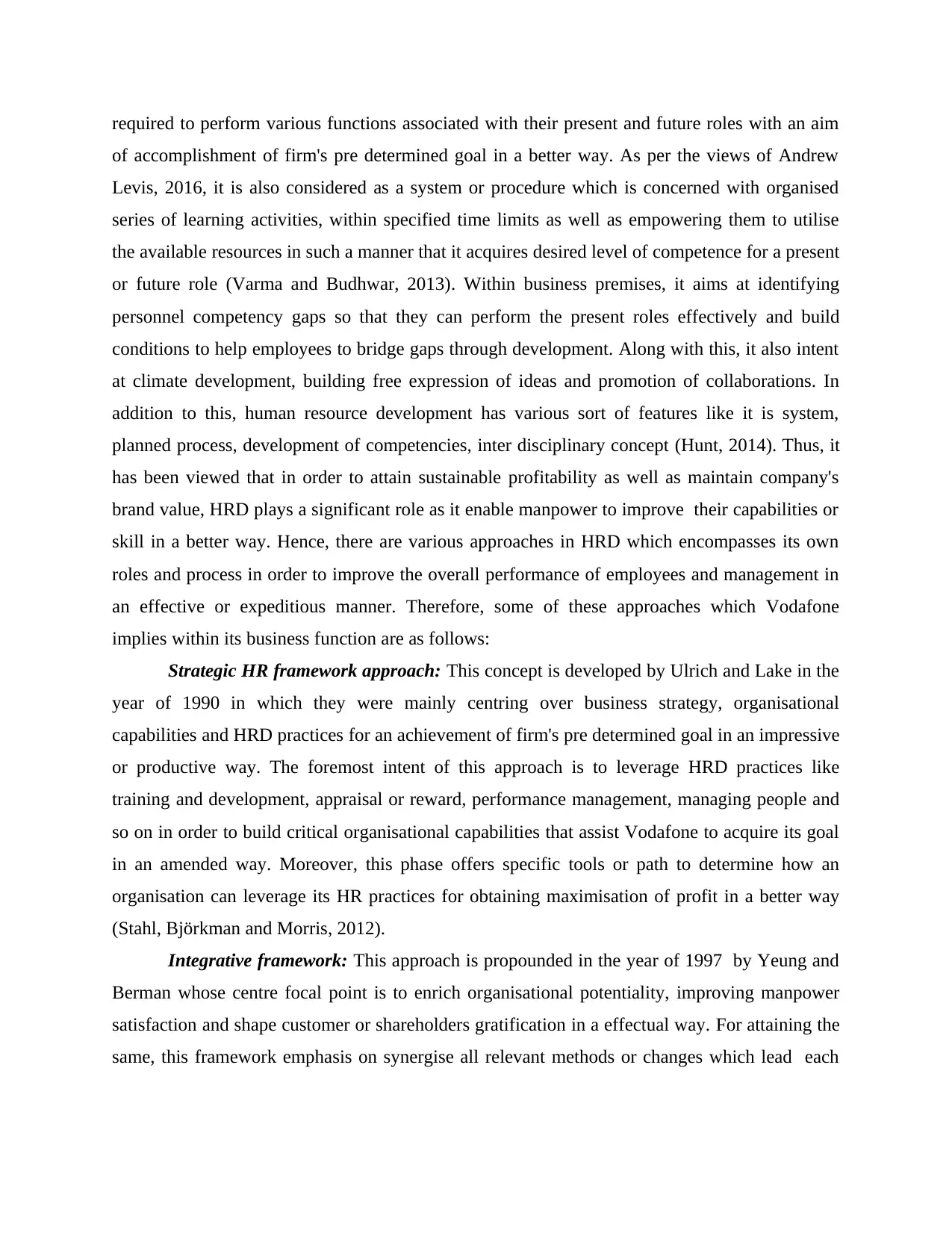
required to perform various functions associated with their present and future roles with an aim
of accomplishment of firm's pre determined goal in a better way. As per the views of Andrew
Levis, 2016, it is also considered as a system or procedure which is concerned with organised
series of learning activities, within specified time limits as well as empowering them to utilise
the available resources in such a manner that it acquires desired level of competence for a present
or future role (Varma and Budhwar, 2013). Within business premises, it aims at identifying
personnel competency gaps so that they can perform the present roles effectively and build
conditions to help employees to bridge gaps through development. Along with this, it also intent
at climate development, building free expression of ideas and promotion of collaborations. In
addition to this, human resource development has various sort of features like it is system,
planned process, development of competencies, inter disciplinary concept (Hunt, 2014). Thus, it
has been viewed that in order to attain sustainable profitability as well as maintain company's
brand value, HRD plays a significant role as it enable manpower to improve their capabilities or
skill in a better way. Hence, there are various approaches in HRD which encompasses its own
roles and process in order to improve the overall performance of employees and management in
an effective or expeditious manner. Therefore, some of these approaches which Vodafone
implies within its business function are as follows:
Strategic HR framework approach: This concept is developed by Ulrich and Lake in the
year of 1990 in which they were mainly centring over business strategy, organisational
capabilities and HRD practices for an achievement of firm's pre determined goal in an impressive
or productive way. The foremost intent of this approach is to leverage HRD practices like
training and development, appraisal or reward, performance management, managing people and
so on in order to build critical organisational capabilities that assist Vodafone to acquire its goal
in an amended way. Moreover, this phase offers specific tools or path to determine how an
organisation can leverage its HR practices for obtaining maximisation of profit in a better way
(Stahl, Björkman and Morris, 2012).
Integrative framework: This approach is propounded in the year of 1997 by Yeung and
Berman whose centre focal point is to enrich organisational potentiality, improving manpower
satisfaction and shape customer or shareholders gratification in a effectual way. For attaining the
same, this framework emphasis on synergise all relevant methods or changes which lead each
of accomplishment of firm's pre determined goal in a better way. As per the views of Andrew
Levis, 2016, it is also considered as a system or procedure which is concerned with organised
series of learning activities, within specified time limits as well as empowering them to utilise
the available resources in such a manner that it acquires desired level of competence for a present
or future role (Varma and Budhwar, 2013). Within business premises, it aims at identifying
personnel competency gaps so that they can perform the present roles effectively and build
conditions to help employees to bridge gaps through development. Along with this, it also intent
at climate development, building free expression of ideas and promotion of collaborations. In
addition to this, human resource development has various sort of features like it is system,
planned process, development of competencies, inter disciplinary concept (Hunt, 2014). Thus, it
has been viewed that in order to attain sustainable profitability as well as maintain company's
brand value, HRD plays a significant role as it enable manpower to improve their capabilities or
skill in a better way. Hence, there are various approaches in HRD which encompasses its own
roles and process in order to improve the overall performance of employees and management in
an effective or expeditious manner. Therefore, some of these approaches which Vodafone
implies within its business function are as follows:
Strategic HR framework approach: This concept is developed by Ulrich and Lake in the
year of 1990 in which they were mainly centring over business strategy, organisational
capabilities and HRD practices for an achievement of firm's pre determined goal in an impressive
or productive way. The foremost intent of this approach is to leverage HRD practices like
training and development, appraisal or reward, performance management, managing people and
so on in order to build critical organisational capabilities that assist Vodafone to acquire its goal
in an amended way. Moreover, this phase offers specific tools or path to determine how an
organisation can leverage its HR practices for obtaining maximisation of profit in a better way
(Stahl, Björkman and Morris, 2012).
Integrative framework: This approach is propounded in the year of 1997 by Yeung and
Berman whose centre focal point is to enrich organisational potentiality, improving manpower
satisfaction and shape customer or shareholders gratification in a effectual way. For attaining the
same, this framework emphasis on synergise all relevant methods or changes which lead each
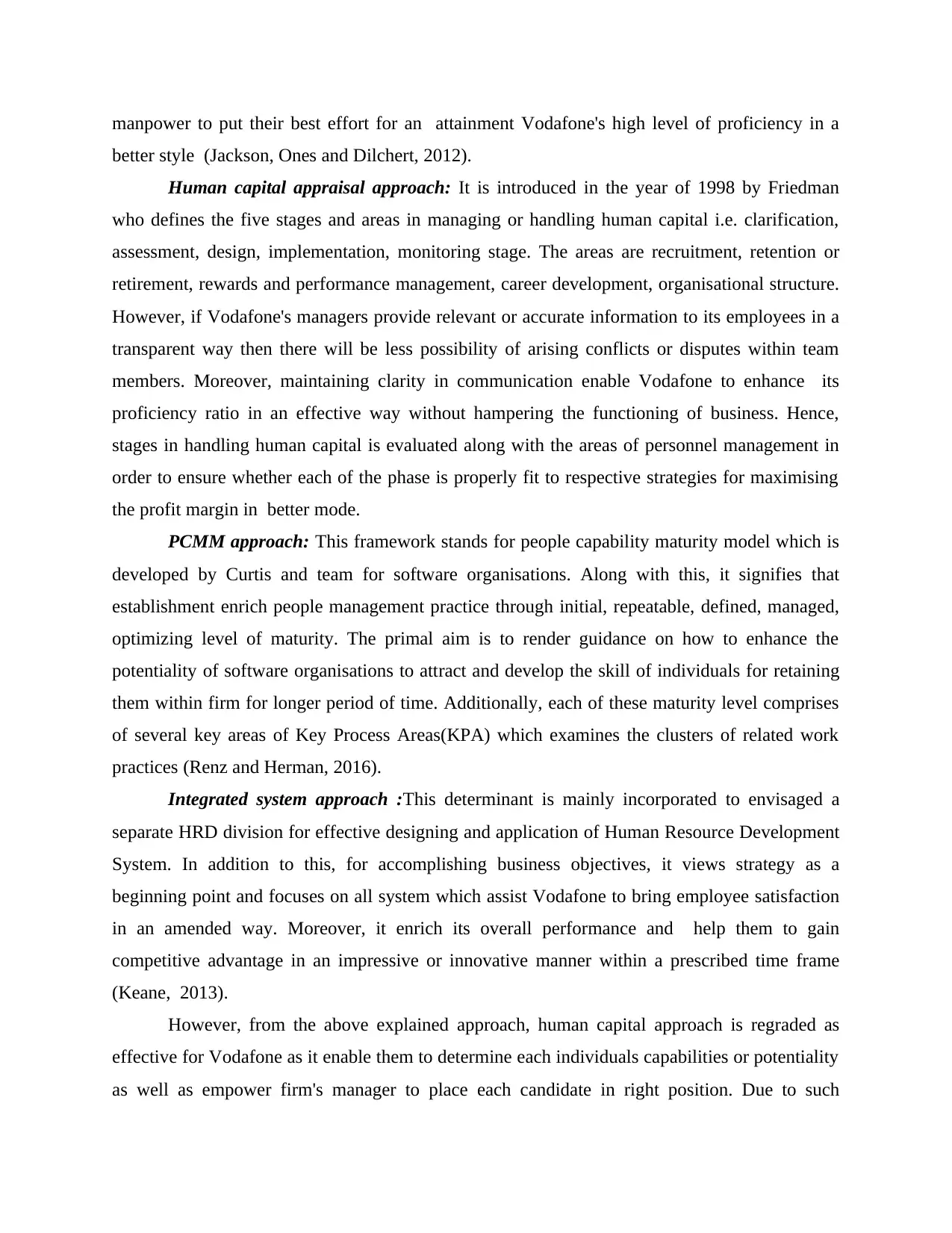
manpower to put their best effort for an attainment Vodafone's high level of proficiency in a
better style (Jackson, Ones and Dilchert, 2012).
Human capital appraisal approach: It is introduced in the year of 1998 by Friedman
who defines the five stages and areas in managing or handling human capital i.e. clarification,
assessment, design, implementation, monitoring stage. The areas are recruitment, retention or
retirement, rewards and performance management, career development, organisational structure.
However, if Vodafone's managers provide relevant or accurate information to its employees in a
transparent way then there will be less possibility of arising conflicts or disputes within team
members. Moreover, maintaining clarity in communication enable Vodafone to enhance its
proficiency ratio in an effective way without hampering the functioning of business. Hence,
stages in handling human capital is evaluated along with the areas of personnel management in
order to ensure whether each of the phase is properly fit to respective strategies for maximising
the profit margin in better mode.
PCMM approach: This framework stands for people capability maturity model which is
developed by Curtis and team for software organisations. Along with this, it signifies that
establishment enrich people management practice through initial, repeatable, defined, managed,
optimizing level of maturity. The primal aim is to render guidance on how to enhance the
potentiality of software organisations to attract and develop the skill of individuals for retaining
them within firm for longer period of time. Additionally, each of these maturity level comprises
of several key areas of Key Process Areas(KPA) which examines the clusters of related work
practices (Renz and Herman, 2016).
Integrated system approach :This determinant is mainly incorporated to envisaged a
separate HRD division for effective designing and application of Human Resource Development
System. In addition to this, for accomplishing business objectives, it views strategy as a
beginning point and focuses on all system which assist Vodafone to bring employee satisfaction
in an amended way. Moreover, it enrich its overall performance and help them to gain
competitive advantage in an impressive or innovative manner within a prescribed time frame
(Keane, 2013).
However, from the above explained approach, human capital approach is regraded as
effective for Vodafone as it enable them to determine each individuals capabilities or potentiality
as well as empower firm's manager to place each candidate in right position. Due to such
better style (Jackson, Ones and Dilchert, 2012).
Human capital appraisal approach: It is introduced in the year of 1998 by Friedman
who defines the five stages and areas in managing or handling human capital i.e. clarification,
assessment, design, implementation, monitoring stage. The areas are recruitment, retention or
retirement, rewards and performance management, career development, organisational structure.
However, if Vodafone's managers provide relevant or accurate information to its employees in a
transparent way then there will be less possibility of arising conflicts or disputes within team
members. Moreover, maintaining clarity in communication enable Vodafone to enhance its
proficiency ratio in an effective way without hampering the functioning of business. Hence,
stages in handling human capital is evaluated along with the areas of personnel management in
order to ensure whether each of the phase is properly fit to respective strategies for maximising
the profit margin in better mode.
PCMM approach: This framework stands for people capability maturity model which is
developed by Curtis and team for software organisations. Along with this, it signifies that
establishment enrich people management practice through initial, repeatable, defined, managed,
optimizing level of maturity. The primal aim is to render guidance on how to enhance the
potentiality of software organisations to attract and develop the skill of individuals for retaining
them within firm for longer period of time. Additionally, each of these maturity level comprises
of several key areas of Key Process Areas(KPA) which examines the clusters of related work
practices (Renz and Herman, 2016).
Integrated system approach :This determinant is mainly incorporated to envisaged a
separate HRD division for effective designing and application of Human Resource Development
System. In addition to this, for accomplishing business objectives, it views strategy as a
beginning point and focuses on all system which assist Vodafone to bring employee satisfaction
in an amended way. Moreover, it enrich its overall performance and help them to gain
competitive advantage in an impressive or innovative manner within a prescribed time frame
(Keane, 2013).
However, from the above explained approach, human capital approach is regraded as
effective for Vodafone as it enable them to determine each individuals capabilities or potentiality
as well as empower firm's manager to place each candidate in right position. Due to such
⊘ This is a preview!⊘
Do you want full access?
Subscribe today to unlock all pages.

Trusted by 1+ million students worldwide
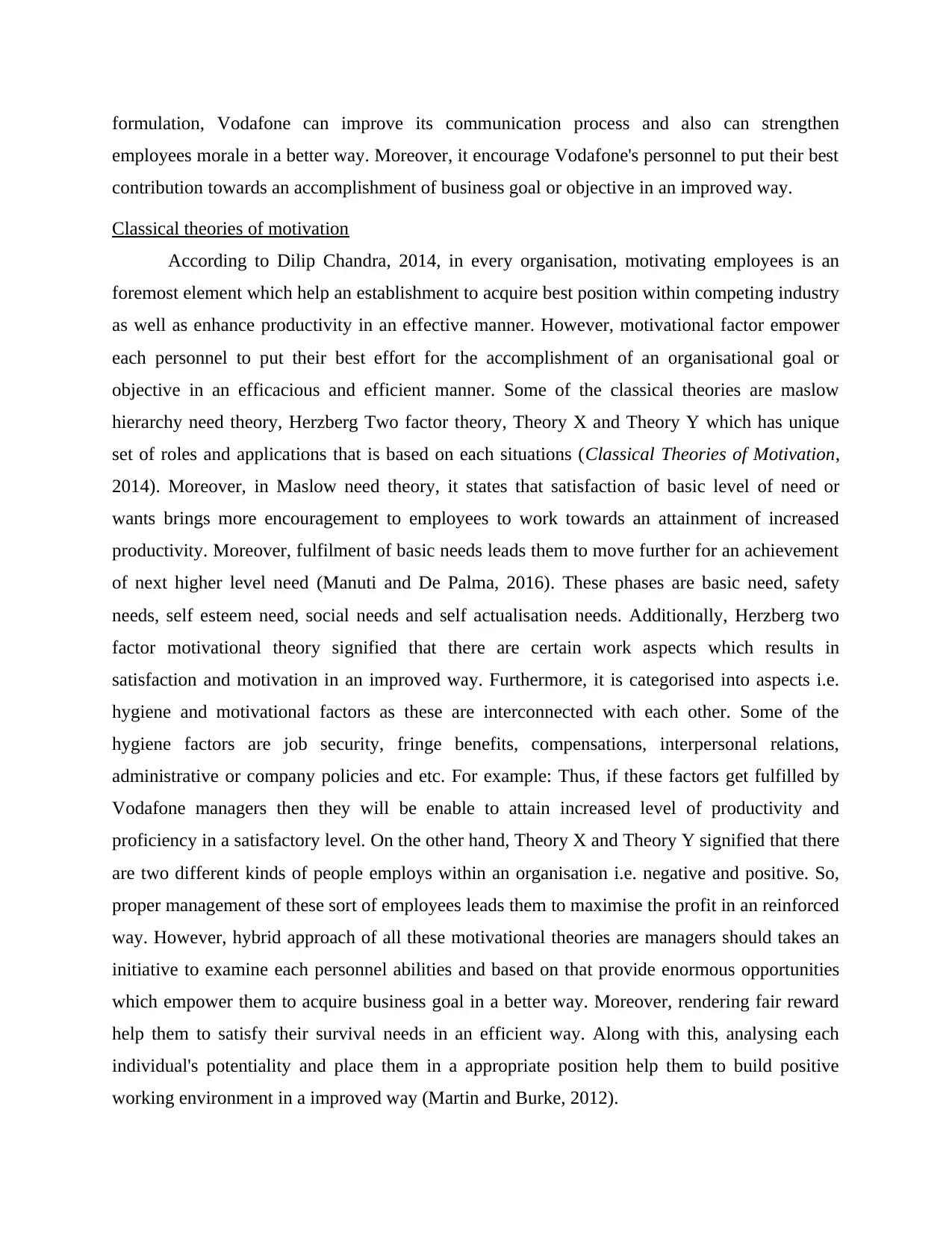
formulation, Vodafone can improve its communication process and also can strengthen
employees morale in a better way. Moreover, it encourage Vodafone's personnel to put their best
contribution towards an accomplishment of business goal or objective in an improved way.
Classical theories of motivation
According to Dilip Chandra, 2014, in every organisation, motivating employees is an
foremost element which help an establishment to acquire best position within competing industry
as well as enhance productivity in an effective manner. However, motivational factor empower
each personnel to put their best effort for the accomplishment of an organisational goal or
objective in an efficacious and efficient manner. Some of the classical theories are maslow
hierarchy need theory, Herzberg Two factor theory, Theory X and Theory Y which has unique
set of roles and applications that is based on each situations (Classical Theories of Motivation,
2014). Moreover, in Maslow need theory, it states that satisfaction of basic level of need or
wants brings more encouragement to employees to work towards an attainment of increased
productivity. Moreover, fulfilment of basic needs leads them to move further for an achievement
of next higher level need (Manuti and De Palma, 2016). These phases are basic need, safety
needs, self esteem need, social needs and self actualisation needs. Additionally, Herzberg two
factor motivational theory signified that there are certain work aspects which results in
satisfaction and motivation in an improved way. Furthermore, it is categorised into aspects i.e.
hygiene and motivational factors as these are interconnected with each other. Some of the
hygiene factors are job security, fringe benefits, compensations, interpersonal relations,
administrative or company policies and etc. For example: Thus, if these factors get fulfilled by
Vodafone managers then they will be enable to attain increased level of productivity and
proficiency in a satisfactory level. On the other hand, Theory X and Theory Y signified that there
are two different kinds of people employs within an organisation i.e. negative and positive. So,
proper management of these sort of employees leads them to maximise the profit in an reinforced
way. However, hybrid approach of all these motivational theories are managers should takes an
initiative to examine each personnel abilities and based on that provide enormous opportunities
which empower them to acquire business goal in a better way. Moreover, rendering fair reward
help them to satisfy their survival needs in an efficient way. Along with this, analysing each
individual's potentiality and place them in a appropriate position help them to build positive
working environment in a improved way (Martin and Burke, 2012).
employees morale in a better way. Moreover, it encourage Vodafone's personnel to put their best
contribution towards an accomplishment of business goal or objective in an improved way.
Classical theories of motivation
According to Dilip Chandra, 2014, in every organisation, motivating employees is an
foremost element which help an establishment to acquire best position within competing industry
as well as enhance productivity in an effective manner. However, motivational factor empower
each personnel to put their best effort for the accomplishment of an organisational goal or
objective in an efficacious and efficient manner. Some of the classical theories are maslow
hierarchy need theory, Herzberg Two factor theory, Theory X and Theory Y which has unique
set of roles and applications that is based on each situations (Classical Theories of Motivation,
2014). Moreover, in Maslow need theory, it states that satisfaction of basic level of need or
wants brings more encouragement to employees to work towards an attainment of increased
productivity. Moreover, fulfilment of basic needs leads them to move further for an achievement
of next higher level need (Manuti and De Palma, 2016). These phases are basic need, safety
needs, self esteem need, social needs and self actualisation needs. Additionally, Herzberg two
factor motivational theory signified that there are certain work aspects which results in
satisfaction and motivation in an improved way. Furthermore, it is categorised into aspects i.e.
hygiene and motivational factors as these are interconnected with each other. Some of the
hygiene factors are job security, fringe benefits, compensations, interpersonal relations,
administrative or company policies and etc. For example: Thus, if these factors get fulfilled by
Vodafone managers then they will be enable to attain increased level of productivity and
proficiency in a satisfactory level. On the other hand, Theory X and Theory Y signified that there
are two different kinds of people employs within an organisation i.e. negative and positive. So,
proper management of these sort of employees leads them to maximise the profit in an reinforced
way. However, hybrid approach of all these motivational theories are managers should takes an
initiative to examine each personnel abilities and based on that provide enormous opportunities
which empower them to acquire business goal in a better way. Moreover, rendering fair reward
help them to satisfy their survival needs in an efficient way. Along with this, analysing each
individual's potentiality and place them in a appropriate position help them to build positive
working environment in a improved way (Martin and Burke, 2012).
Paraphrase This Document
Need a fresh take? Get an instant paraphrase of this document with our AI Paraphraser
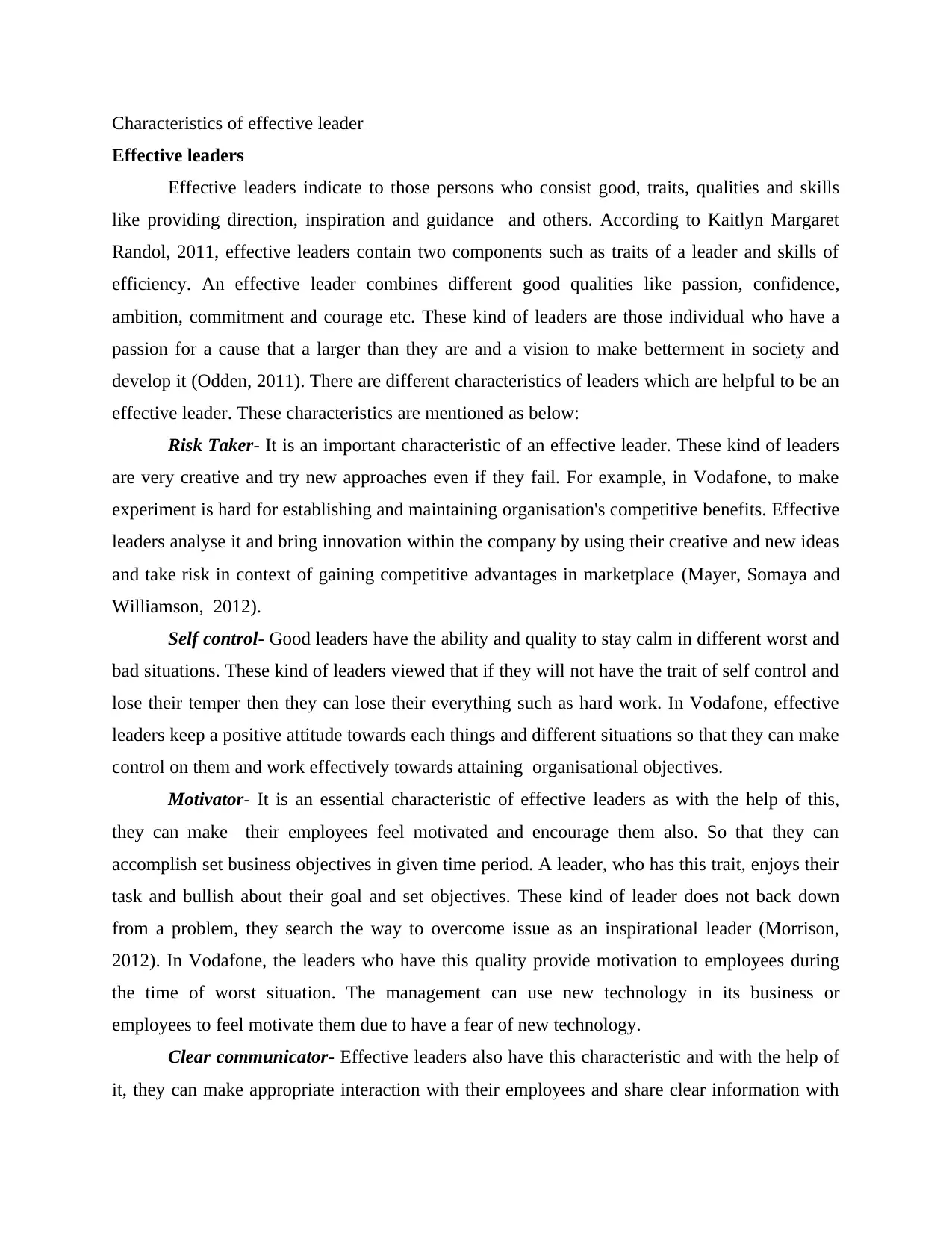
Characteristics of effective leader
Effective leaders
Effective leaders indicate to those persons who consist good, traits, qualities and skills
like providing direction, inspiration and guidance and others. According to Kaitlyn Margaret
Randol, 2011, effective leaders contain two components such as traits of a leader and skills of
efficiency. An effective leader combines different good qualities like passion, confidence,
ambition, commitment and courage etc. These kind of leaders are those individual who have a
passion for a cause that a larger than they are and a vision to make betterment in society and
develop it (Odden, 2011). There are different characteristics of leaders which are helpful to be an
effective leader. These characteristics are mentioned as below:
Risk Taker- It is an important characteristic of an effective leader. These kind of leaders
are very creative and try new approaches even if they fail. For example, in Vodafone, to make
experiment is hard for establishing and maintaining organisation's competitive benefits. Effective
leaders analyse it and bring innovation within the company by using their creative and new ideas
and take risk in context of gaining competitive advantages in marketplace (Mayer, Somaya and
Williamson, 2012).
Self control- Good leaders have the ability and quality to stay calm in different worst and
bad situations. These kind of leaders viewed that if they will not have the trait of self control and
lose their temper then they can lose their everything such as hard work. In Vodafone, effective
leaders keep a positive attitude towards each things and different situations so that they can make
control on them and work effectively towards attaining organisational objectives.
Motivator- It is an essential characteristic of effective leaders as with the help of this,
they can make their employees feel motivated and encourage them also. So that they can
accomplish set business objectives in given time period. A leader, who has this trait, enjoys their
task and bullish about their goal and set objectives. These kind of leader does not back down
from a problem, they search the way to overcome issue as an inspirational leader (Morrison,
2012). In Vodafone, the leaders who have this quality provide motivation to employees during
the time of worst situation. The management can use new technology in its business or
employees to feel motivate them due to have a fear of new technology.
Clear communicator- Effective leaders also have this characteristic and with the help of
it, they can make appropriate interaction with their employees and share clear information with
Effective leaders
Effective leaders indicate to those persons who consist good, traits, qualities and skills
like providing direction, inspiration and guidance and others. According to Kaitlyn Margaret
Randol, 2011, effective leaders contain two components such as traits of a leader and skills of
efficiency. An effective leader combines different good qualities like passion, confidence,
ambition, commitment and courage etc. These kind of leaders are those individual who have a
passion for a cause that a larger than they are and a vision to make betterment in society and
develop it (Odden, 2011). There are different characteristics of leaders which are helpful to be an
effective leader. These characteristics are mentioned as below:
Risk Taker- It is an important characteristic of an effective leader. These kind of leaders
are very creative and try new approaches even if they fail. For example, in Vodafone, to make
experiment is hard for establishing and maintaining organisation's competitive benefits. Effective
leaders analyse it and bring innovation within the company by using their creative and new ideas
and take risk in context of gaining competitive advantages in marketplace (Mayer, Somaya and
Williamson, 2012).
Self control- Good leaders have the ability and quality to stay calm in different worst and
bad situations. These kind of leaders viewed that if they will not have the trait of self control and
lose their temper then they can lose their everything such as hard work. In Vodafone, effective
leaders keep a positive attitude towards each things and different situations so that they can make
control on them and work effectively towards attaining organisational objectives.
Motivator- It is an essential characteristic of effective leaders as with the help of this,
they can make their employees feel motivated and encourage them also. So that they can
accomplish set business objectives in given time period. A leader, who has this trait, enjoys their
task and bullish about their goal and set objectives. These kind of leader does not back down
from a problem, they search the way to overcome issue as an inspirational leader (Morrison,
2012). In Vodafone, the leaders who have this quality provide motivation to employees during
the time of worst situation. The management can use new technology in its business or
employees to feel motivate them due to have a fear of new technology.
Clear communicator- Effective leaders also have this characteristic and with the help of
it, they can make appropriate interaction with their employees and share clear information with
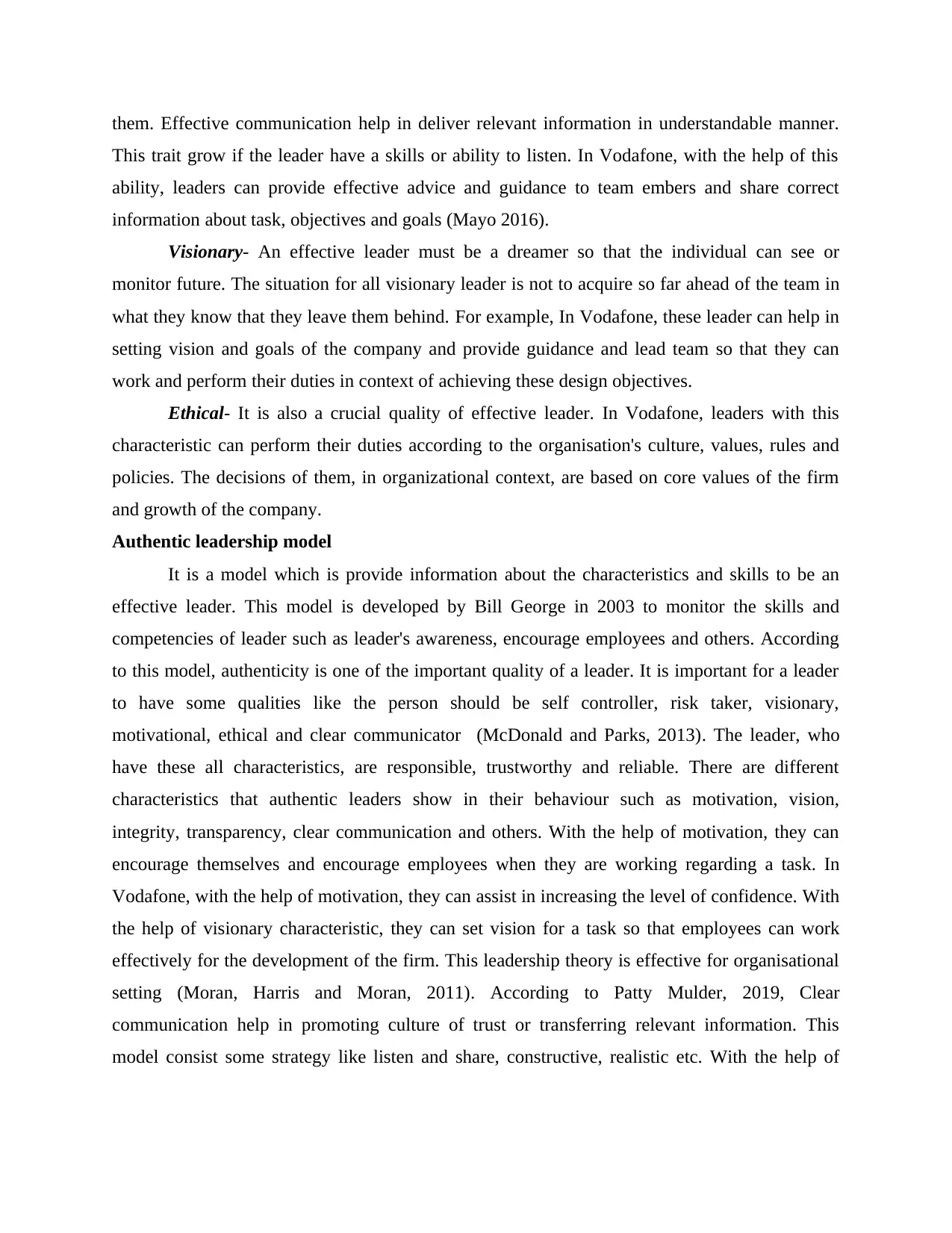
them. Effective communication help in deliver relevant information in understandable manner.
This trait grow if the leader have a skills or ability to listen. In Vodafone, with the help of this
ability, leaders can provide effective advice and guidance to team embers and share correct
information about task, objectives and goals (Mayo 2016).
Visionary- An effective leader must be a dreamer so that the individual can see or
monitor future. The situation for all visionary leader is not to acquire so far ahead of the team in
what they know that they leave them behind. For example, In Vodafone, these leader can help in
setting vision and goals of the company and provide guidance and lead team so that they can
work and perform their duties in context of achieving these design objectives.
Ethical- It is also a crucial quality of effective leader. In Vodafone, leaders with this
characteristic can perform their duties according to the organisation's culture, values, rules and
policies. The decisions of them, in organizational context, are based on core values of the firm
and growth of the company.
Authentic leadership model
It is a model which is provide information about the characteristics and skills to be an
effective leader. This model is developed by Bill George in 2003 to monitor the skills and
competencies of leader such as leader's awareness, encourage employees and others. According
to this model, authenticity is one of the important quality of a leader. It is important for a leader
to have some qualities like the person should be self controller, risk taker, visionary,
motivational, ethical and clear communicator (McDonald and Parks, 2013). The leader, who
have these all characteristics, are responsible, trustworthy and reliable. There are different
characteristics that authentic leaders show in their behaviour such as motivation, vision,
integrity, transparency, clear communication and others. With the help of motivation, they can
encourage themselves and encourage employees when they are working regarding a task. In
Vodafone, with the help of motivation, they can assist in increasing the level of confidence. With
the help of visionary characteristic, they can set vision for a task so that employees can work
effectively for the development of the firm. This leadership theory is effective for organisational
setting (Moran, Harris and Moran, 2011). According to Patty Mulder, 2019, Clear
communication help in promoting culture of trust or transferring relevant information. This
model consist some strategy like listen and share, constructive, realistic etc. With the help of
This trait grow if the leader have a skills or ability to listen. In Vodafone, with the help of this
ability, leaders can provide effective advice and guidance to team embers and share correct
information about task, objectives and goals (Mayo 2016).
Visionary- An effective leader must be a dreamer so that the individual can see or
monitor future. The situation for all visionary leader is not to acquire so far ahead of the team in
what they know that they leave them behind. For example, In Vodafone, these leader can help in
setting vision and goals of the company and provide guidance and lead team so that they can
work and perform their duties in context of achieving these design objectives.
Ethical- It is also a crucial quality of effective leader. In Vodafone, leaders with this
characteristic can perform their duties according to the organisation's culture, values, rules and
policies. The decisions of them, in organizational context, are based on core values of the firm
and growth of the company.
Authentic leadership model
It is a model which is provide information about the characteristics and skills to be an
effective leader. This model is developed by Bill George in 2003 to monitor the skills and
competencies of leader such as leader's awareness, encourage employees and others. According
to this model, authenticity is one of the important quality of a leader. It is important for a leader
to have some qualities like the person should be self controller, risk taker, visionary,
motivational, ethical and clear communicator (McDonald and Parks, 2013). The leader, who
have these all characteristics, are responsible, trustworthy and reliable. There are different
characteristics that authentic leaders show in their behaviour such as motivation, vision,
integrity, transparency, clear communication and others. With the help of motivation, they can
encourage themselves and encourage employees when they are working regarding a task. In
Vodafone, with the help of motivation, they can assist in increasing the level of confidence. With
the help of visionary characteristic, they can set vision for a task so that employees can work
effectively for the development of the firm. This leadership theory is effective for organisational
setting (Moran, Harris and Moran, 2011). According to Patty Mulder, 2019, Clear
communication help in promoting culture of trust or transferring relevant information. This
model consist some strategy like listen and share, constructive, realistic etc. With the help of
⊘ This is a preview!⊘
Do you want full access?
Subscribe today to unlock all pages.

Trusted by 1+ million students worldwide
1 out of 15
Related Documents
Your All-in-One AI-Powered Toolkit for Academic Success.
+13062052269
info@desklib.com
Available 24*7 on WhatsApp / Email
![[object Object]](/_next/static/media/star-bottom.7253800d.svg)
Unlock your academic potential
Copyright © 2020–2025 A2Z Services. All Rights Reserved. Developed and managed by ZUCOL.





